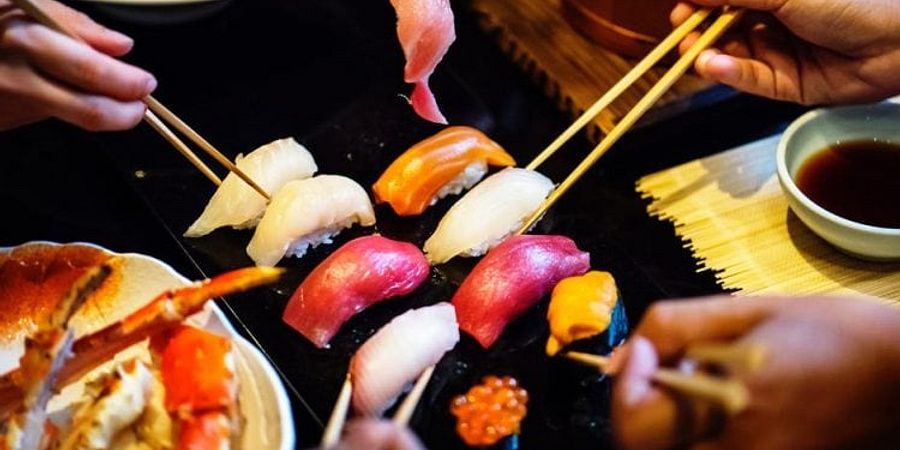Putting Your Sushi on Display with a Sushi Case

The saying our “eyes are bigger than our stomach” oftentimes rings true for hungry customers. Your sushi is delicious, the ingredients fresh, the price right, but there’s one thing you might be missing - the visual appeal.
Showcasing your sushi with an attractive, refrigerated sushi case is necessary. It heightens the appeal of the sushi itself! Read on to learn how to choose the best sushi case for your restaurant or deli to entice your customers.
Features to Consider for Your Sushi Case
The sushi cases may look similar. There are several different features that are important to take into account when choosing your sushi case. These include how big you want your sushi case to be, the lighting inside, and how it is refrigerated.
Size
Sushi cases range in size from small 47 inches to very wide 82 inches. Choosing the size all depends on your budget, the amount of space you have, and how much sushi you would like to display.
Also, make sure you have the specification sheet on hand. You want to avoid the nasty surprise of having a sushi case that needs to be returned. It’s either too small or too large for your space!
For instance, the Hoshizaki HNC-120BA-R-SLH is a 48 inch wide curved glass sushi case. It has a front to the back interior of 11 inches. This still leaves you plenty of room to display numerous plates of delicious sushi in an affordable way. This is perfect for smaller establishments with less counter space room.
The Hoshizaki HNC-210BA-L-SL, on the other hand, is a large 83 inch wide curved glass case, making it far easier to display a variety of sushi for a larger restaurant with plenty of counter space room and clearance on all sides.
Lighting
Lighting may be something you wouldn’t consider as much as size, but it plays an equally important role in showcasing your sushi. For example, sushi cases with LED lights, such as the Hoshizaki HNC-150BA-L-SL, keep the sushi brightly and evenly illuminated.
This increases the appeal for customers as it enhances your sushi’s bright colors. LED lighting doesn’t add an odd tinge of color to your sushi, so your sushi is showcased front and center in an accurate way.
Moreover, LED lighting is incredibly energy efficient, saving you a lot of money in the long term. The light positions will also vary - some have lights at the top of the units, others have them on the shelves.
The lighting style you choose all depends on your personal preference. There really is no right or wrong choice in terms of lighting, just as long as it’s bright enough for your customers to ogle the food.
Refrigeration
There are two kinds of refrigeration types when it comes to sushi cases: forced air and gravity coil.
Chilled air is circulated throughout the case. This forced air keeps your sushi nice and cool, and it’s seen in establishments with pre-packaged food. However, because of the circulating air, this may be drying for your sushi after a long amount of time.
Take your client flow into account when thinking about if forced air is the right refrigerant type for you. With a steady flow of clients, you won’t have to worry about your sushi drying.
In comparison, the gravity coil refrigeration removes the drying effect. It drops, not forces, the chilled air onto your sushi from above. This is the refrigeration type commonly used with deli meats at your local supermarket. It’s also a preferred option for most low-budget restaurants.
The Turbo Air SAK-70R-N is unique in that it uses the eco-friendly technology of hydrocarbon refrigerants. They don’t deplete our ozone layer and meet the EPA and DOE standards of 2017.
Condensing Unit
All of GoFoodservice’s sushi display cases have self-contained refrigeration units. You don’t have to worry about additional space being taken up. The condensers are located on either the left or right sides of the case.
Style
Once you know what features you would like for your sushi case, taking into account size, lighting and refrigeration next is the style of your case. While the units may look similar, there are slight differences in coloring and shape that can make a difference in how your sushi presents to customers.
For instance, many sushi cases come with curved glass fronts that appear more elegant, such as the Hoshizaki HNC-180BA-L-SL. Others have an angled top that slants downward in a straight diagonal like the Turbo Air SAK-60L-N. This gives the sushi case a more modern appearance that harkens back to diners in the past.
No matter what glass shape you choose, both kinds are made to reduce glare from exterior lighting. Your customers always have a perfect view of your sushi inside.
Some sushi cases will have a black interior to give a more dramatic appearance. This is perfect for restaurants with customers that normally come for dinner dates or important black-tie events.
As you can see, style is about your own personal aesthetic but also about keeping with your restaurant’s brand and image. A sushi case with a black interior and curved front may not match a restaurant that is mainly catering to on-the-go contractors that just want a healthy, quick bite to eat.
Now You Know the Case on Sushi
As you can see, there are specifications and differences that need to be taken into account. This is so you to make an informed decision about what sushi case to purchase. It all depends on your knowledge of your restaurant’s needs, brand, and client flow throughout the day.
While sushi display cases keep sushi fresh, the main idea is to display them in the best light possible light. After all, when we go out to eat we tend to choose with our eyes as well as our stomachs.
Don't forget to check out our buying guides while you're on the site.
Share This!